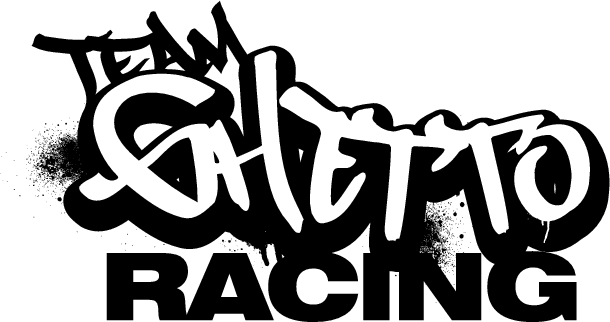Oils (and other fluids) for the Gen4 Jimny JB/JC74
This is an area of endless debate so I thought I’d capture everything about the key fluids for the car. This isn’t the ‘how to change these fluids’ page, this is the ‘what fluids’ page. If you’re looking for how to service the car, then my Jimny servicing page is for you.
The range of Suzuki official lubricants and fluids is here, provided by Ecstar Europe.
Sections
- Quick reference table
- Engine oil
- Manual transmission oil
- Automatic transmission fluid
- Transfer case oil
- Differential oil
- Coolant
- Brake fluid
- Front CV grease
- Propeller shafts
- Power steering
- A discussion: Suzuki OEM fluids/greases/sealants and who makes them
Quick reference table
| Fill area | Viscosity / type | Capacity | Oher |
|---|---|---|---|
| Engine oil | 0W20 (5W30) synthetic | 4L including filter | Synthetic; GF-6A; SN API grade |
| M/T oil | 75W-80 GL-4 | 1.2L | Synthetic recommended; note GL-4 Suzuki recommend using the same as the transfer case. |
| A/T fluid | Suzuki 3317 | ~3-4L (5.7L total fill on overhaul) | Suzuki ATF3317, with these fluids meeting it or recommended as compatible: * Ecstar ATF 3317 * Castrol TRANSMAX Dexron®-VI Mercon® LV Multivehicle * Penrite ATF FS |
| Transfer case | 75W-80 GL-4 | 1.2L | Also GL-4 fluid as contains synchroniser on high<->low shift Suzuki recommend the same as the manual transmission. |
| Differential | 75W-85 GL-5 | Front: 1.6L Rear: 1.3L | Note GL-5, fully synthetic highly recommended |
| Coolant | Long life glycol | 5L | Cars until mid 2022 received Suzuki blue ultra long life coolant; now receive green long life coolant. Suzuki Queensland cars all seem to be filled with green coolant, though |
| Brake fluid | DOT3 | ~800 mL if completely dry | Note shared reservoir for brakes and clutch on manual cars; only DOT3 is required although DOT4 can be used |
| Front CV grease | Suzuki Super Grease C – 99000-25030 (tan, lithium based) | ~100 g per CV | Hard to get specs on the grease; a translation of the German cross-reference guide suggests it’s an NLGI 2 lithium grease, waterproof and -25 to 180º C thermal resistance. I generally recommend a high moly but lithium based grease for CVs or maybe Castrol LMM. Just clean the swivel hub and axle out fully. Also use this grease for the kingpin bearings if they’re dry. |
| Kingpin bearings | Not specified | Enough | Use the same as the front CV grease when you rebuild swivel hubs |
| Propeller shafts | Suzuki Super Grease C – 99000-25030 (tan, lithium based) | Till it comes out of uni joints; a small smear on the sliding joint on front propshaft | Plenty of sites seem to say this is also Super Grease A, but the part number matches what the workshop instructions call Super Grease C. |
| Power steering | It doesn’t need any: all electric | Electrons | Just make sure the car can supply electrons |
Engine oil
I currently run: Penrite Enviro+ 0W-20 and it needs ~4L to fill sump and the oil filter
This is the engine oil chart for markets other than Europe (where 0W16 is the recommended oil).
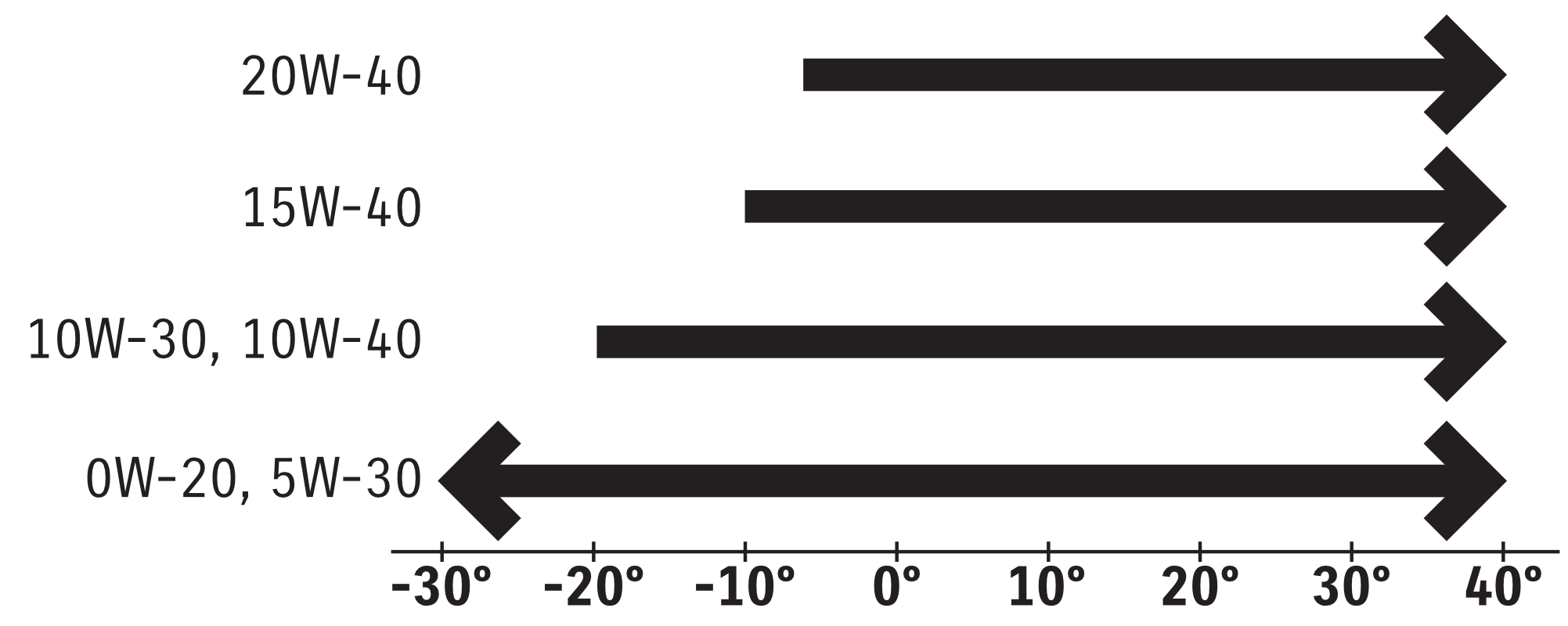
As you can see, there is a range of recommended viscosities depending on ambient temperature; however, the standard fill oil is a 0W20 oil. While arguments abound about low viscosity oil and how they’re only valid for ensuring better emissions numbers, cars in general have been lasting ever longer despite lower engine oil viscosities and longer oil change intervals. In Australia, note that many dealerships stick with a 5W30 oil for the Jimnys as a) it’s what they have to hand for most of their other cars and b) it’s marginally cheaper.
The problem with going too thick with an oil is slower lubrication on startup and more potential for the oil to bypass the filter where it exceeds either filter pressure drop or bulk oil pressure due to its thickness. Arguments against thin oil generally are around engine longevity, though the bulk of engine wear is on startup around the piston rings/bores and potentially thicker oils don’t do anything to help there. The K15B engine runs relatively tight bearing tolerances and piston clearances, so I err on the side of the thinnest oil I’m comfortable with: I run the factory recommended 0W20 oil.
Delving deeper: why would it be so thin?
When I refer to tighter tolerances, here’s a comparison of tolerances between the M13A engines used in a gen3 Jimny and the K15B in a gen4 Jimny.
| M13A SN413 | K15B A6G415 | Which is tighter? | |
|---|---|---|---|
| Main bearing clearance | ~45 mm crank journal diameter, clearances are 0.025 mm – 0.045 mm (0.06 – 0.1%), limit 0.065 mm (0.14%) | ~45 mm crank journal diameter, clearances are Bearing 1: 0.014-0.032 mm (~0.031 – 0.071%), limit 0.055 mm (~0.1%) Other bearings: 0.016 – 0.034 mm (~0.035 – 0.076%), limit 0.050 mm (~0.1%) | K15B |
| Big end clearance | ~42 mm crank pin diameter, clearances are 0.029 – 0.047 mm (0.07 – 0.1%), limit 0.065 mm (0.15%) | ~38 mm crank pin diameter, clearances are 0.031 – 0.049 mm (0.08 – 0.13%), limit 0.065 (0.17%) | M13A |
| Little end clearance | ~20 mm wrist pin diameter, clearances are 0.003 – 0.014 mm (0.02 – 0.1%) | ~18 mm wrist pin diameter, clearances are 0.003 – 0.017 mm (0.02 – 0.1%) | M13A |
| Cam journal clearance | #1 bearings (~26.95 mm): 0.045 – 0.087 mm (0.2 – 0.3%), limit 0.12 mm (0.5%) Others: (~23.00 mm): 0.045 – 0.087 mm (0.2 – 0.4%), limit 0.12 mm (0.5%) | Intake #1 (~29.45 mm): 0.031 – 0.081 mm (0.1 – 0.3%), limit 0.10 mm (0.3%) Exhaust #1 (~26.95 mm): 0.045 – 0.087 mm (0.2 – 0.3%), limit 0.10 mm (0.4%) Others (~22.95 mm): 0.045 – 0.087 mm (0.2 – 0.4%), limit 0.10 mm (0.4%) | K15B |
| Piston to bore clearance | Bore 78 mm New: 0.032 – 0.061 mm (0.04% to 0.08%) Limit: 0.161 mm (0.2%) | Bore 74 mm New: -0.016 to 0.030 mm (0 to 0.04%) Used: 0.010 to 0.036 mm (0.01% to 0.05%) Limit: 0.072 mm (0.1%) | K15B |
| Piston ring end gaps | Top: 0.20 – 0.35 mm (0.3 – 0.4%), limit 0.7 mm (0.9%) 2nd: 0.30 – 0.45 mm (0.4 – 0.6%), limit 1.0 mm (1.3%) Oil: 0.20 – 0.7 mm (0.3 – 0.9%), limit 1.5 mm (1.9%) | Top: 0.15 – 0.25 mm (0.2 – 0.3%), limit 0.7 mm (0.9%) 2nd: 0.25 – 0.38 mm (0.3 – 0.5%), limit 1.0 mm (1.4%) Oil: 0.10 – 0.40 mm (0.1 – 0.5%), limit 1.2 mm (1.6%) | K15B |
In short: most tolerances, even accounting for different diameters of the starting material, are tighter compared to a gen3 Jimny (which was specced for 5W30 oil, and up to 10W40 in hot climates). The tolerances are that much tighter, and that necessitates a thinner oil. In particular, the main bearings and also the piston to bore clearances are reasonably tighter than the M13A engine. This isn’t unexpected, but it does mean thinner oil is the sensible choice due to these tighter tolerances. Yes, in some ways the K15B is not a sophisticated modern engine, but it has the tolerances to be one.
Ignoring that, if you are in favour of a thicker oil I suggest you go back and read some of the linked content I’ve provided. Engines (and cars) are lasting longer than ever before, despite thinner oils changed less often. There’s good science that the oil viscosity isn’t going to do too much for the predominant area of engine wear which is around the piston, rings and bores. Bearing numbers in the lab are one thing, and wear scars are super dramatic to look at, but that isn’t even the major part to worry about with car engines (save for design flaws like BMW V10 rod bearings).
Ultimately: Honda studied 0W-20 oil in 1999, and concluded
We at Honda have been striving to develop fuel-efficient engine oils and applying them to models to have more and more fuel saving automobiles. To be more specific, the improvements have been done for mineral oil with High Viscosity Index (hereafter referred to as HVI) base oil. Our study with HVI base oil has continued and eventually led to development of an SAE 0W-20 grade engine oil that provides additional fuel savings. It showed a fuel economy improvement of 1.5%. Due to concerns about abrasion resistance and oil consumption related to the reduced oil viscosity, vehicle testing was conducted. That testing demonstrated these problems did not occur.
As per this video from Engineering Explained which also cite this paper:
there’s surprisingly no incentive for manufacturers to go too thin. If they go thinner oil than optimum then friction actually increases, so there’s no economy benefit to going thinner than optimum, along with more wear if they had gone thinner than optimum. This is counter-intuitive to many people, but it makes sense. Manufacturers have progressed to thinner and thinner oil because they have been able to do so and make engines last longer. Sticking to the manufacturer’s recommended grade is therefore the best option.
Some options and basic specifications
As discussed below, the factory Ecstar oil is manufactured by ENEOS, but its specifications do not match an equivalent from ENEOS exactly (and I’ve also used a TotalEnergies oil which appears to be supplying the base for Maruti based Ecstar oils). I’ve compiled some key basic specifications to act as a comparison. I list things such as performance standards based on the highest they reach; many are listed as reaching a number of different standards. Not all manufacturers provide all basic comparison data, either, but I’ve done my best to compile them where appropriate.
This isn’t intended to be used as the definitive recommendation, but is a point of comparison to the factory Ecstar oil in 0W-20 grade.
| Oil | Performance | Density @ 15ºC (kg/L) | Kinematic viscosity @ 40º C (cSt) | Kinematic viscosity @ 100º C (cSt) | Viscosity index | Total base number | Pour point |
|---|---|---|---|---|---|---|---|
| Ecstar F9000 0W-20 | API SN, GF-6A | 0.85 | 47.2 | 8.8 | 167 | – | < -45º C |
| ENEOS X Prime 0W-20 | API SP/RC, GF-6A | 0.844 | 28.3 | 7.6 | 258 | 5.6 | -52.5º C |
| TotalEnergies QUARTZ INEO XTRA EC6 0W-20 | API SP/RC, GF-6A | 0.845 | 41.6 | 8.6 | 176 | – | -48º C |
| Penrite Enviro+ 0W-20 | API SP/RC, GF-6A | 0.847 | 41 | 7.9 | 168 | 8.5 | – |
| Penrite Enviro+ C5 0W-20 | API SP/RC, GF-6A | 0.847 | 42 | 8.5 | 180 | 8.2 | – |
| Shell Helix Ultra SP 0W-20 | API SP, GF-5 | 0.836 | 42.1 | 8.0 | – | – | -54º C |
| Valvoline Synpower 0W-20 | API SQ, SN/RC, GF-7A | 0.8465 | 43.2 | 8.3 | 171 | 7.7 | -45º C |
| Mobil Super 3000 0W-20 | API SP/RC, GF-6A | 0.847 | 44.9 | 8.5 | 170 | – | -42º C |
| Mobil 1 0W-20 | API SP/RC, GF-6A | 0.841 | 44.8 | 8.7 | 173 | 8.8 | – |
| Liqui Moly Special Tec AA 0W-20 | API SP, GF-6A | 0.845 | 44.0 | 8.5 | 175 | 8.5 | -42º C |
| Liqui Moly Top Tec 6200 0W-20 | ACEA C5 | 0.845 | 44.0 | 8.4 | 180 | 9.2 | -45º C |
| Castrol Edge C5 0W-20 | API SP, GF-6 | 0.843 | – | 8.2 | 166 | – | -42º C |
| Castrol Edge Fluid TITANIUM 0W-20 | API SP, GF-6 | 0.85 | 43 | 8.6 | 183 | – | -39º C |
| Castrol Magnatec 0W-20 | API SP, GF-6 | 0.846 | 46.0 | 8.6 | 170 | – | -45º C |
| Castrol Magnatec 0W-20 C5 | API SQ, ACEA C5 | 0.846 | 42 | 8.0 | 165 | – | -42º C |
| Nulon Apex+ Eco-GF6 0W-20 | API SP, GF-6A | – | – | – | – | – | – |
| Motul 8100 Eco-lite 0W-20 | API SP, GF-6A | 0.842 | 45.2 | 8.4 | 162 | 8.4 | -42º C |
| Red Line 0W-20 | API SP | – | 50 | 9.0 | 164 | – | -47º C |
| Toyota Synthetic 0W-20 (Idemitsu) | API SP, GF-6 | 0.8497 | 37.03 | – | – | – | < -50.0 °C |
| Amsoil Signature Series 0W-20 ASM | API SP/RC, GF-6A | – | 47.1 | 8.8 | 169 | 12.5 | -53º C |
| Hi-Tec Synplus 0W20 SP GF-6 | AP SP, GF-6A | 0.849 | 41.6 | 8.0 | 170 | 7.48 | – |
| Royal Purple Motor Oil 0W-20 | API SP/RC, GF-6A | – | 45.8 | 8.6 | 168 | 8.9 | -47º C |
| Caltex Havoline ProDS ECO SAE 0W-20 | API SP, GF-6A | 0.844 | 44.3 | 8.4 | 169 | – | -45º C |
As you can see, there can be a reasonably wide variation in these standard properties across oils all meeting a nominal 0W-20 grade. Interestingly to me there doesn’t appear to be a retail oil from either ENEOS or TotalEnergies which matches the Ecstar F9000 oil that is nominally the OEM oil.
Manual transmission oil
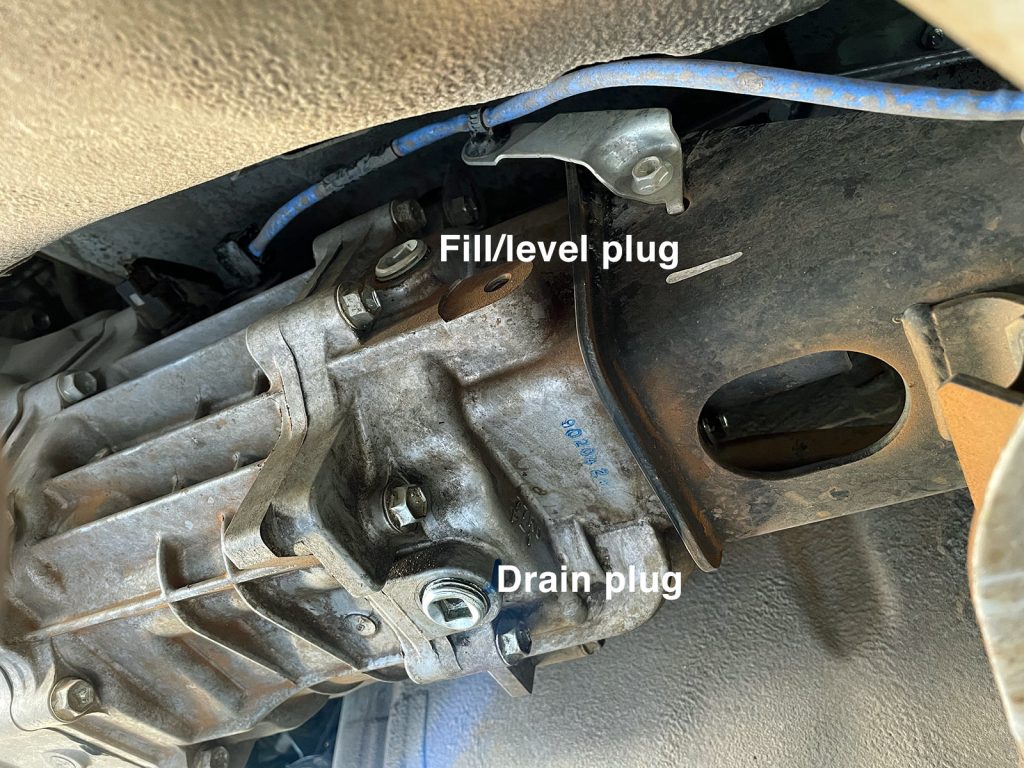
I currently run: Penrite Pro-gear 70W-75 full synthetic and it needs 1.2L to fill; I will also try some Red Line MT-LV 70W75 GL-4 oil at my next change to see if it changes shifting characteristics.
It’s a relatively simple and oldschool 5 speed manual transmission, so not super critical on fluid choice here. Interestingly Suzuki’s workshop manual recommends Suzuki Gear Oil 75W but then they give a viscosity chart for 75W-80. Seems to shift nice and fine with the 70W-75 in it and no changes in noise or appreciable metal in the oil.
Suzuki’s 75W fully synthetic gear oil is manufactured by Shell.
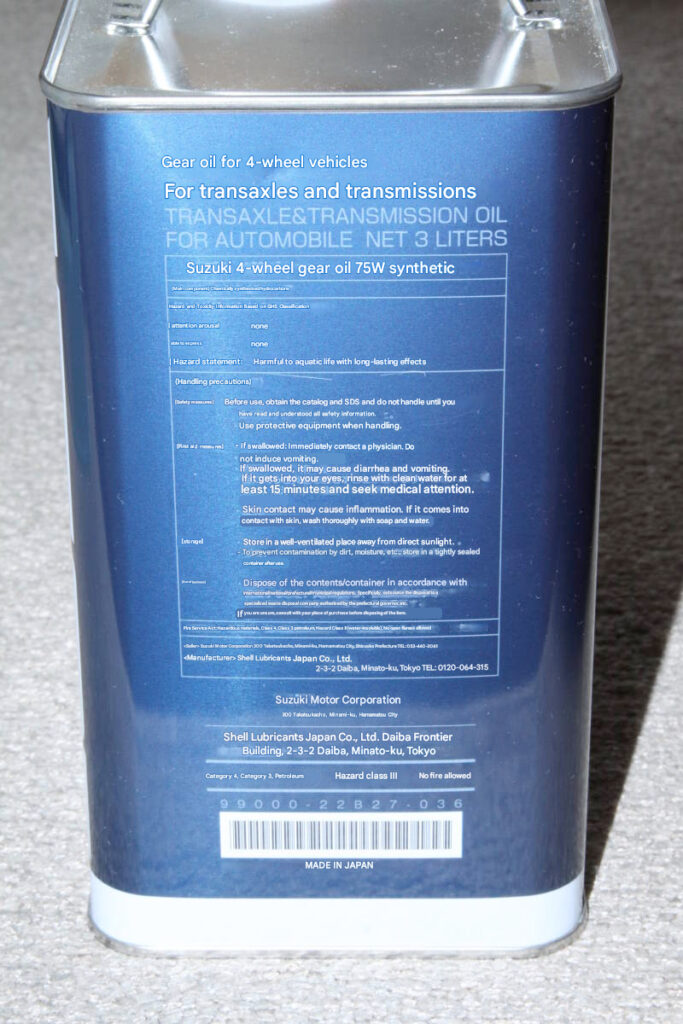
Shell do not seem to retail a straight 75W fully synthetic GL-4 gear oil, so it looks like this is formulated to something bespoke to Suzuki. The closest appears to be Shell Spirax S4 G 75W-80.
I think people under-change manual transmission fluids, they cop a beating in something where you’re perpetually rowing the gears so for me this is a once-every-2-years at a minimum. Reality is it’s done when I do the transfer case, which I generally do after a lot of heavy 4wding, so more frequently than every 2 years.
Interestingly, Penrite (used to, they changed it June 2025) suggest a semi-synthetic 75W80 fluid here, but then suggest fully synthetic 70W75 for the transfer case even though Suzuki themselves suggest the same oil for both. I’ve been using the thinner oil since my first change and seems fine.
EDIT: As of June 2025, Penrite now suggest their Pro Gear GL-4 70W75 for both manual transmission and transfer case.
Some people look towards running a thicker oil for longevity. I’m not sure this is a good idea because the Jimny does have relatively slow synchros, and thicker oil just makes them slower.
| Part number/reference | Viscosity/standards compliance | Notes | |
|---|---|---|---|
| Suzuki OEM gear oil (fully synthetic) | 99000-22B27-036 (1L) | 75W; API GL-4 | Suzuki note this to be a 75W gear oil, but then provide viscosity chart for 75W80 gear oil Same as Suzuki recommend for transfer case |
| Shell Spirax S4 75W-80 | 550054730 | 75W-80; API GL-4 | Shell manufacturer the Ecstar 75W fully synthetic gear oil specified for the Jimny’s manual transmission but there is no direct equivalent retail product |
| Penrite Trans Gear 75W-80 (semi-synthetic) | TG7580001 (1L); TG75800025 (2.5L) | 75W-80; API GL-4, GL-4+ | Penrite’s recommendation, but does not match their transfer case recommendation |
| Penrite Pro-Gear 70W75 | PROG70750025 (2.5L) | 70W-75; API GL-4, GL-4+ | I have run this for ~4 years, has worked well |
| Red Line MT-LV (fully synthetic) | 83522 50604 5 (1 qt; 0.946 L) | 70W/75W; API GL-4 | Currently testing this; matches the stock straight viscosity of 75W. |
| Red Line MTL (fully synthetic) | 50204 | 80W, 75W-80; API GL-4 | Although it nominally matches the factory 75W-80 oil, it is listed also as a straight 80W oil (which is thicker than standard) |
| RAVENOL MTF-3 SAE 75W (fully synthetic) | 1221104-001 (1L) | 75W; API GL-4 | Searching for the Suzuki part number often redirects you here; appears to be closest match to factory fluid? |
| Castrol Castrol TRANSMAX Manual Z Long Life 75W-80 (fully synthetic) | 75W-80; API GL-4 | Formerly Syntrans Z LL 75W-80 Seemingly hard to find in retail sized packs | |
| Hi Tec Syngear Eco-M 75W/80 GL-4 (fully synthetic) | 75W-80; API GL-4 | ||
| Gulf Western Ultra Shift M MTF 75W-80 (fully synthetic) | 304061 (4L) | 75W-80; API GL-4 | |
| Nulon 75W-80 smooth shift manual and transaxle Oil (semi synthetic) | SS75W80 | 75W-80; API GL-4 | Comes in a squeezy sack which can be nice for filling |
| Nulon 75W-85 Manual Gearbox and Transaxle Oil (fully synthetic) | SYN75W85 | 75W-80; API GL-4 | Comes in a squeezy sack which can be nice for filling |
| Caltex Delo® Syn-Trans XV SAE 75W-80 (fully synthetic) | 510405 | 75W-80; API GL-4 | Apparently designed for trucks, but does match the required viscosity |
Automatic transmission fluid
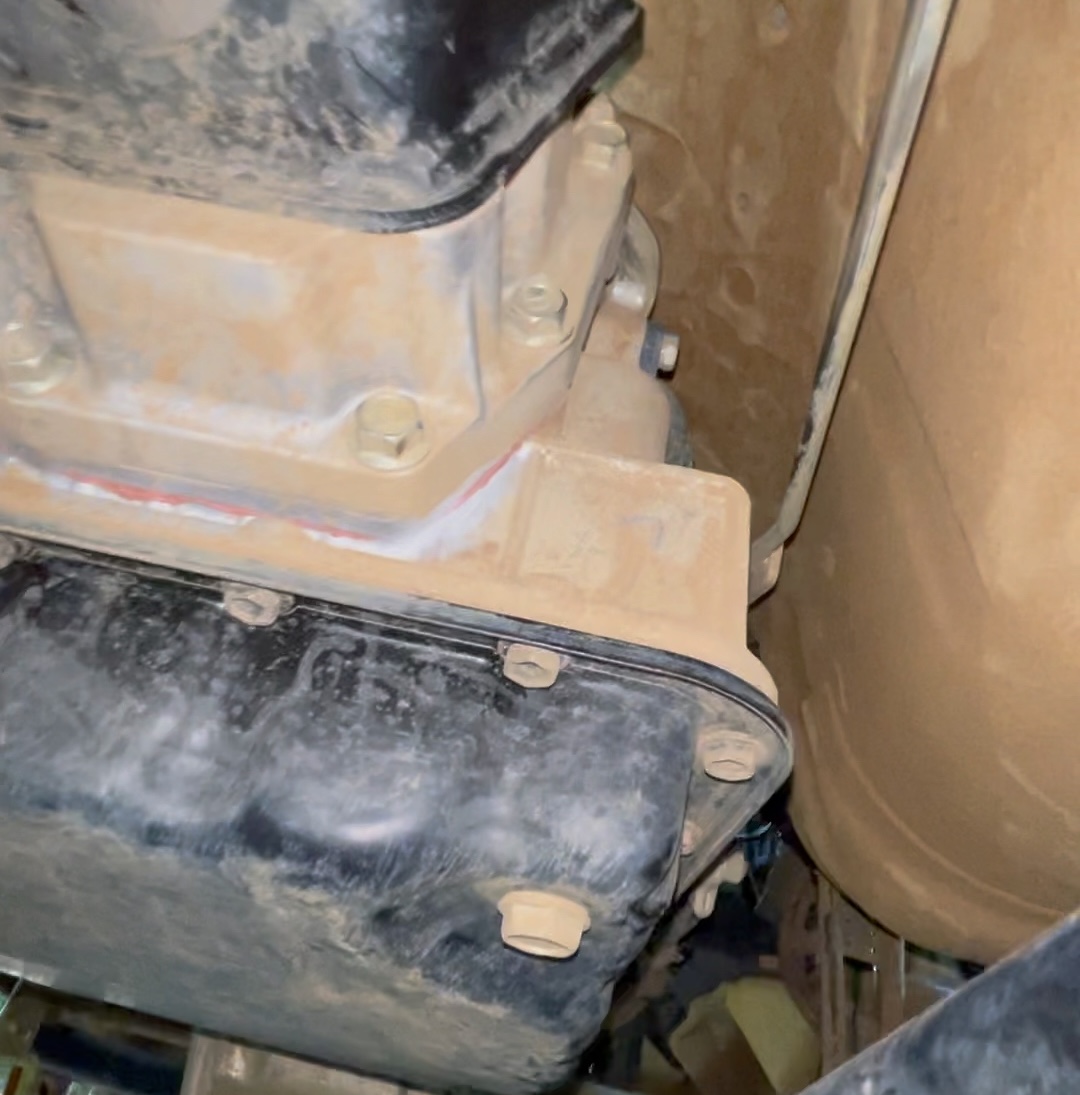
(I don’t have an auto, but if I did I’d probably stick to factory fluid bought from the dealership). It needs ~4L though numbers vary down to 3L for a fluid change (spec is 5.7L for total dry after a rebuild).
This one’s a funny one. The spec is Suzuki ATF3317 which basically noone says they do. It seems to be equivalent to JWS3317, which then people say is equivalent to JWS3309 which a lot more people use. In the owners manual, as opposed to workshop reference material, ATF3309 is also specified.
It’s a relatively oldschool style 4 speed torque converter automatic, however, electronic shifting and usually tight solenoids mean they can still be quite sensitive to fluids; my general advice is to stick to a factory fluid simply because it’s a known quantity. The transmission is ‘self-learning’, not for shift patterns but for shift speeds versus line pressures internally. Quoting the repair instructions:
Optimum line pressure complying with engine torque is produced by the pressure control solenoid valve in dependence upon control signal from TCM. This makes it possible to control the line pressure with high accuracy in accordance with the engine power and running conditions to achieve smooth shifting characteristics and high efficiency in power transmission.
Suzuki JB74 workshop manual
…
A line pressure learning control is conducted to provide optimum shifting time at every upshifting with engine throttle opened. If long upshifting time is detected, the subsequent line pressure applied during upshifting is intensified. On the contrary, if short upshifting time is detected, the subsequent line pressure applied during upshifting is weakened.
Different fluids will have different temperature-viscosity and hence pressure characteristics, which is why shifting can be so sensitive to fluid types (and also fluid contamination).
Both Castrol and Penrite suggest they have fluids compatible. Castrol TRANSMAX Dexron®-VI Mercon® LV Multivehicle explicitly is compatible, Penrite ATF FS is not explicit in its compatibility but Penrite now list it as compatible with the Jimny. The transmission is not hugely different to the gen 3 Jimny automatic, but clearly there are reasons for updating the fluid.
A key challenge with the automatic is just how hard it is to extend the transmission breather. This makes the fluid prone to contamination in certain 4wding conditions (especially deep mud and/or deep water crossings). I would be changing the fluid at the first sign of shifting unhappiness after 4wding. If this is ignored the car can end up stuck in a gear (usually first or second) or end up either not locking up the converter on the highway or the lockup clutch stuck engaged. All of these are clearly a bad time.
Transfer case oil
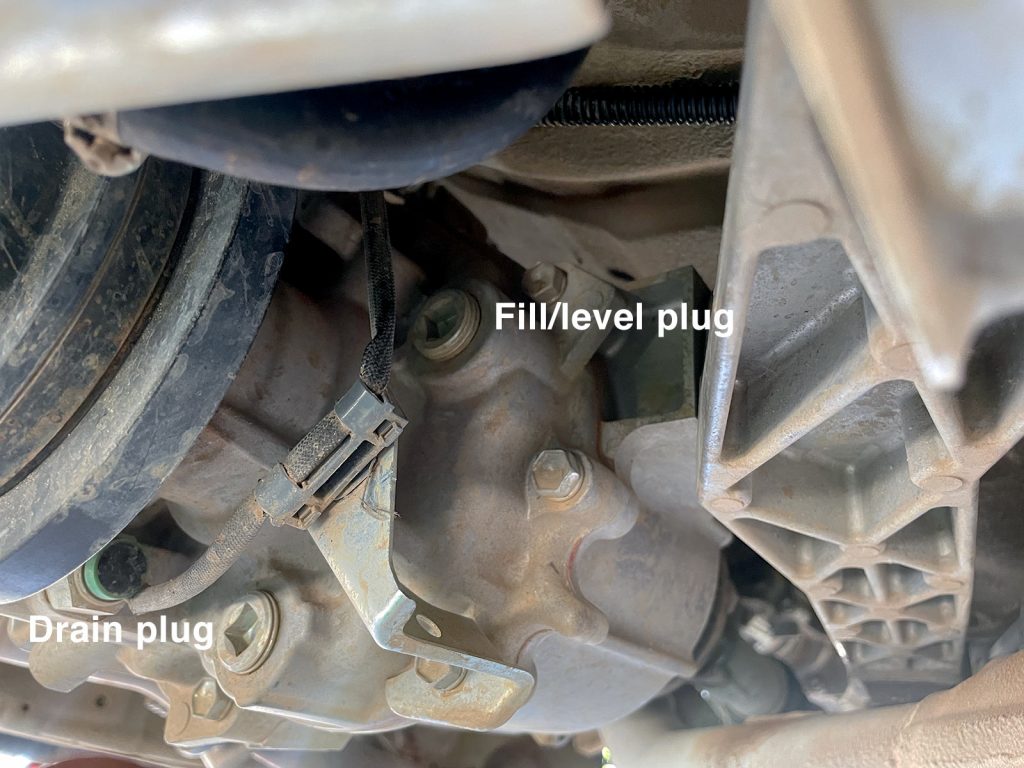
I currently run: Penrite Pro-gear 70W-75 full synthetic and it needs 1L to 1.2L to fill.
This is a pretty uncontroversial area. Suzuki officially specify the same 75W gear oil as the manual transmission, but then are more particular about it being synthetic and show it was a 75W-80 gear oil in the viscosity chart like the manual, too.
I have tried using some anti wear-noise additives to see if that slows down or eases the classic Jimny fart on takeoff from the transfer case chain harmonics, but it doesn’t really seem to do anything. I’m also not seeing any visible wear particles, even after nearly 6 years, from the transfer case chain being noisy, either.
If you use the same fluid as the manual transmission, a 2.5L bottle does both the transmission and transfer case. Makes it an easy change after some heavy 4wding where the transfer case definitely will be seeing some added oil shearing.
Differential oil
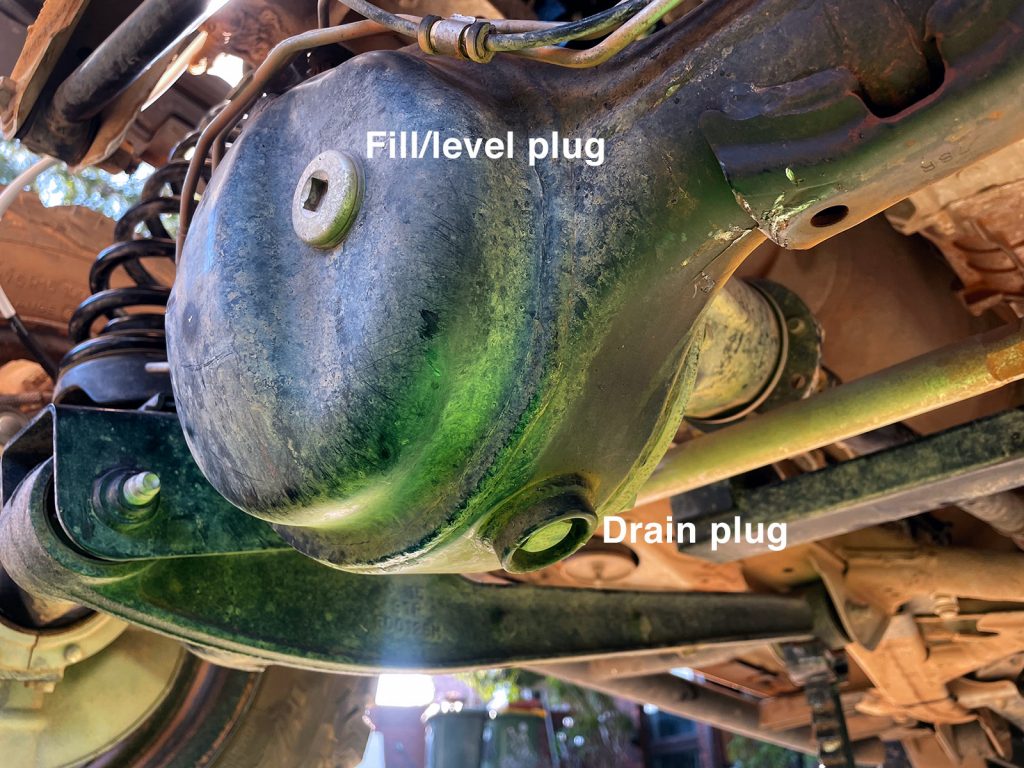
I currently run: Penrite Pro-Gear 75W-85 GL-5 full synthetic; 1.6L front and 1.3L rear fill capacities.
Biggest thing here is ensuring you get a GL-5 spec gear oil for the appropriate extreme pressure wear additives. One of the challenges is that many places do not carry the GL-5 spec synthetic oil in the appropriate viscosity, as the Jimny runs a lower viscosity differential oil than many people might think.
If you have a different differential setup, such as an LSD or a locked diff, then your manufacturer should be consulted. ARB suggest a particular oil for air lockers like I have, but then they also are ok using the factory Suzuki suggestions for the Suzuki lockers. Other brands or types, such as e-lockers, may be different.
Coolant
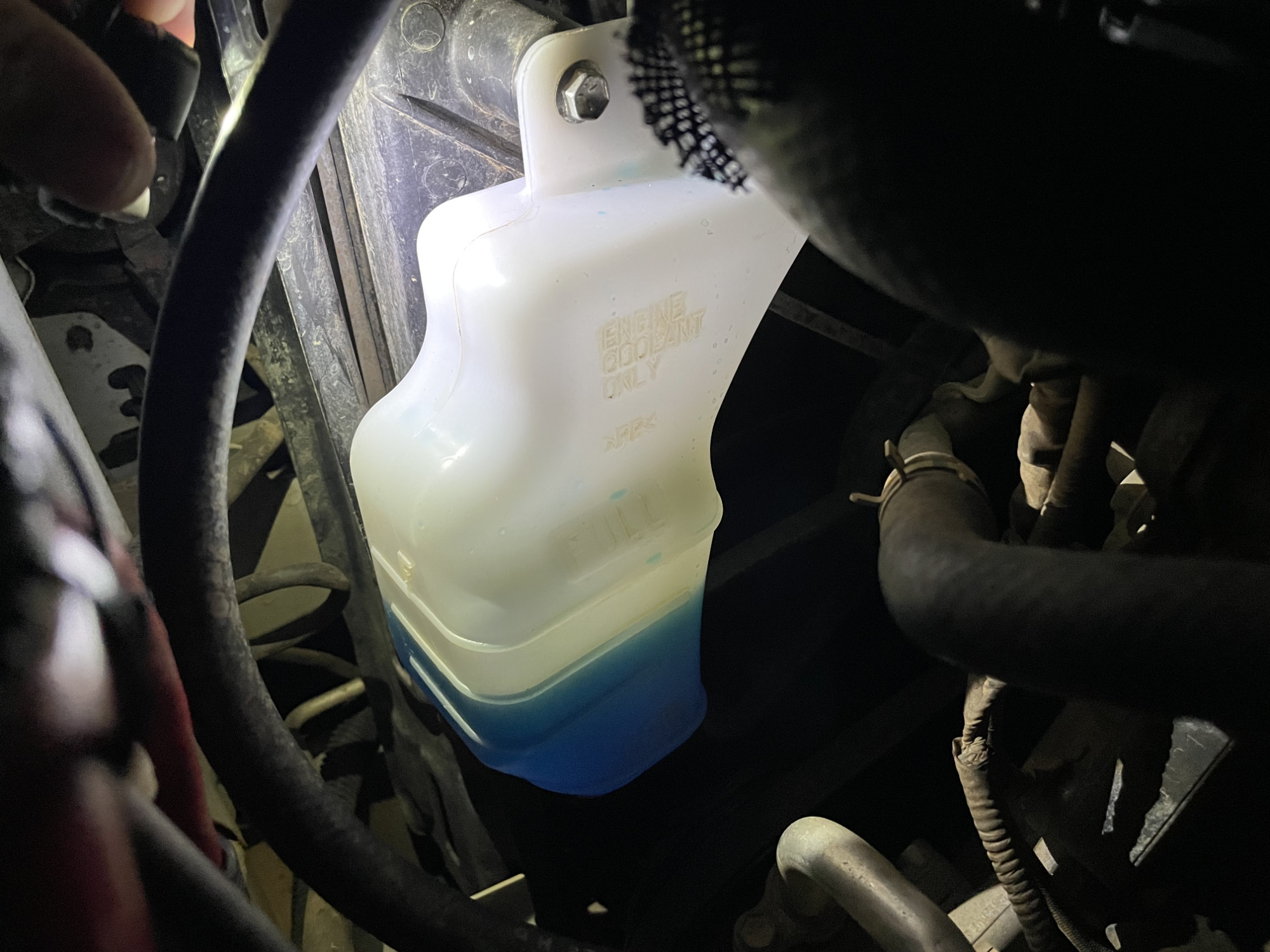
I currently run: whatever factory fill is in mine (blue Suzuki ultra long life coolant)
Coolant’s another interesting one. The original few years of Jimnys coming to Australia received the blue ultra long life coolant. This is scheduled to be replaced after 8 years or 150,000 km, after which it’s 4 years/75,000 km.
At some point, more and more appeared to come with green Suzuki coolant, which is to be replaced every 3 years/45,000 km. Interesting this isn’t listed as part of the official capped price service intervals, so it’s hard to know if it’s just a change in colour to the ultra long life coolant, or, it’s actually the regular long life green coolant.
Coolants can be exceptionally incompatible and so it is generally best to stick with what’s there if you’re doing a coolant change. If you need a small top-up then distilled water is the best call rather than risking incompatible coolants.
The Suzuki blue and green coolants are both ethylene glycol based coolants; however, they do have different additive packages. This additive packages can be the source of incompatibilities between coolant types and why you shouldn’t necessarily mix them.
If you are sticking with the Suzuki coolant then it is available through both Suzuki car and motorcycle dealers. If wanting a similar style coolant but prepared to do a full flush then the Penrite blue ultra long life fluid has similar specs to the factory blue coolant. In applications using the green coolant I have received good service and no corrosion of coolant system components using the Nulon green long life concentrate for another option.
Brake fluid
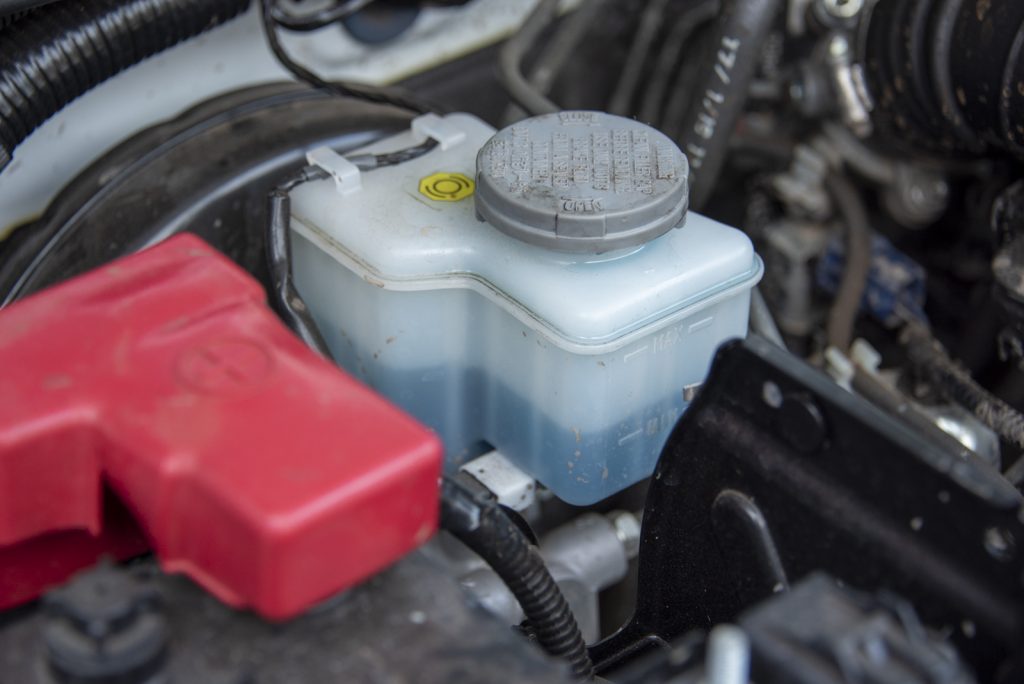
I currently run: whatever is a different colour DOT3 or DOT4 fluid to what I used last time, so I can more easily see when I’m doing a brake fluid flush
This is an often neglected part in any service regime, but especially so on a 4wd. The Jimny is not particularly picky about this fluid: in fact, a DOT3 fluid is all that is required. The Jimny doesn’t really have the braking power (or outright velocity) to warrant the higher boiling point fluids. I generally use a DOT4 fluid since that’s what my other cars use.
Whenever I change the brake fluid (usually every 2 years, but it’s also as often as whenever wheel bearings need doing) I try to use different brands. This is because different brands are (usually) different colours, e.g. swapping between Castrol (a light yellow) and Bendix (a reasonably dark blue) helps me see when the old fluid is out of that brake line and the new fluid is through.
Contrary to popular opinion, you don’t need to do anything special with the ABS pump to flush through fluid or even bleed the brakes (assuming you didn’t get air into the ABS pump, that is). I suck out the reservoir almost entirely, refill with my new fluid right to the top, and then pull fluid through. A full flush like that takes ~500 mL of brake fluid.
Bonus info: brake caliper pin grease
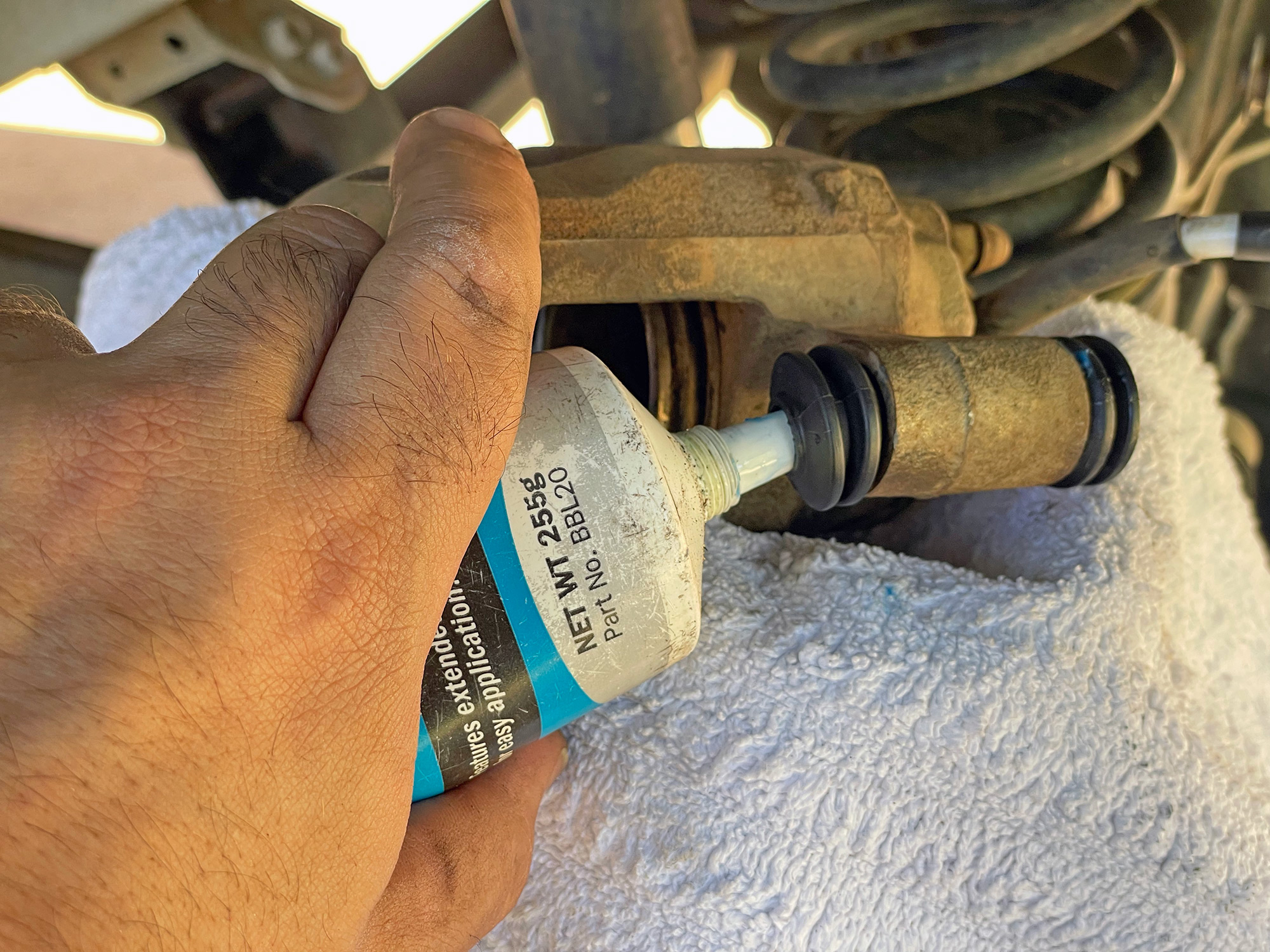
This is even more often forgotten on 4wds! Especially those that go in the mud will have a hard time and you’ll find the sliding caliper pins cop abuse and the caliper will stop sliding. This means you wear out one brake pad per wheel only (rather than both), and you’ll also have a more wooden brake pedal but less stopping power.
Suzuki’s official requirement is just a ‘rubber grease’ but almost all brake service places will recommend a specific high temperature grease for caliper slides. I use a Bendix caliper grease for this, which is available in individual packets at auto parts stores in Australia.
Front CV grease
Look, it’s barely a fluid on human timescales and at room temperature but I don’t see this commonly discussed anywhere and wanted to make sure it’s documented somewhere. Also, I haven’t changed this but I have helped people out who have.
In theory the grease is a lithium based grease, tan in colour and NLGI 2 grade (Suzuki Super Grease “C”, part number 99000–25030). So long as you clean out whatever’s there then you can repack it with anything suitable for CVs; something with a reasonable amount of moly is a good choice for CV longevity. Over the years I have had good experience with Castrol LMM in particular.
This is a good time for a diversion about greases and their bases. Greases are essentially an oil and a thickener, usually a soap. The big thing to understand is that you shouldn’t mix greases of different bases e.g. a lithium versus a calcium versus a sodium grease. Sometimes the base also matters for the purpose of corrosion resistance depending on the metal or other material that the grease is lubricating or protecting.
Assuming there is no corrosion related difference between grease bases, it is possible to wash out an old grease of a different base using solvents and then put in a new grease with whatever base you want. This is often how one deals with unknown OEM greases
Kingpin bearings
Pretty well related to the front CVs, the kingpin bearings are what allow the swivel hub to swivel. When installing them you are meant to re-grease them with “Super Grease C”, part number 99000–25030. Worn kingpin bearings from insufficient/washed out grease is a pretty common cause of steering wobbles in all manner of solid axle 4wds, and the Jimny is no exception.
There are options for sealed kingpin bearings, and even unsealed ones do have sealant applied to the kingpins themselves which I cover in the parts breakdown and the parts needed to repair the swivel hubs over on my buying parts page.
Propeller shafts
The propeller or propshafts (sometimes called driveshafts) are the shafts that run from the output flanges of the transfer case to the differentials, and from the output of the transmission to the input of the transfer case. Workshop instructions indicate three areas to grease on these relating to the universal joints (uni joints), although not all shafts have been manufactured with grease nipples on the uni joints.
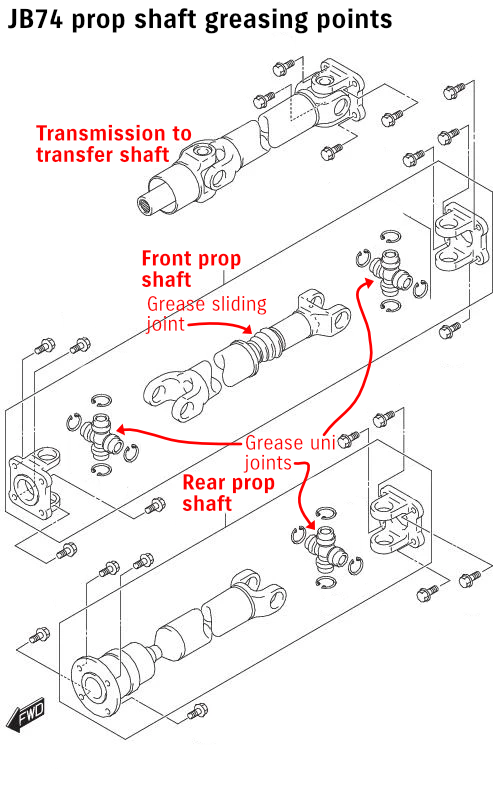
Grease is “Suzuki Grease C” (part number 99000-25030), same as used for front CV joints and the kingpins.
Power steering
I’ve added this only because a few people have asked me about checking or refilling the JB74’s power steering reservoir. The short answer is it doesn’t have one as it uses entirely electric power steering assistance. This is done in the steering column itself.
There would be lubrication included inside the steering box itself but there are no repair instructions or servicing information provided by Suzuki. Presumably the manufacturer of the steering boxes handles that and they are not directly aimed at user servicability (not uncommon in steering boxes). Usually it’s a gear oil a bit like you’d use in the diffs, but without specific instructions it’s all just guesswork anyway.
A discussion: Suzuki OEM fluids/greases/sealants and who makes them
One of the areas that generates heated discussion with people is the topic of the OEM Suzuki oils/lubricants and to a lesser extent their suppliers.
One camp is definitely of the opinion “it doesn’t matter, Suzuki aren’t an oil company, get a good aftermarket fluid and it’ll be cheaper than buying from them”. That might be true, but they also don’t likely do things like cast their own engine blocks, or manufacture their own bearings. They do set specifications for things, including their OEM fluids and there might be some differences.
The other is “only get the OEM fluids, they will be the best”. The counter to this is that most dealerships use lubricant suppliers other than the genuine fluids, which can be difficult to source in Australia. In addition, plenty of the non OEM fluids will be more than adequate and up to the task, if not outperforming the original fluids.
To dig into this I thought I’d do a bit of a deep dive while laid up at home in mid 2025. Note that OEM oils and lubricants are not unique to Suzuki: many car manufacturers have this. Some are just branding deals and are a preference deal for use, e.g. Ferrari and their relationship with Shell, but others can involve significant input by the OEM to make fluids with particular properties to suit their engineering of their products.
Suzuki OEM fluids?
Suzuki produce their own line of OEM fluids under the Ecstar brand. Suzuki launched this brand in 2015 but base it on 30-odd years of research into lubricants and their own needs:
In the 1980’s, SUZUKI started the development of lubricants in pursuit of ultimate performance in the Japanese domestic market.
Global Suzuki: What Is Ecstar
The lubricant is named “Ecstar” as it is our guiding “Star” towards an “Ecstatic” performance.
As the expectation towards our products evolves,
the same attention to performance is required for durability and environmental protection.
Withthe high technology cultivated through its long history and dedicated engineering,
SUZUKI has precisely re-formulated “ECSTAR” to satisfy and exceed these requirements.
In 2015, ECSTAR has been started as the global brand name of SUZUKI Genuine Oil & Chemical .
By enhancing and drawing out the best performance,
“ECSTAR” will give you a SUZUKI experience that others could not.
There are a wide range of fluids offered under the Ecstar branding, primarily engine and transmission oils. Some of these are lubricants brought under the Ecster branding, e.g. the Suzuki grease formerly was advertised under the Suzuki Genuine Parts branding but was updated with a new part number as an Ecstar grease.
Who manufactures the fluids for Suzuki?
TL;DR: Mostly ENEOS. Shell (gear oil, Super Grease A); possibly Mobil for the ATF; and, Threebond for sealants and thread lockers
These sorts of things are often quite hard to find out as brands often are quite protective of their OE supplier. Some car manufacturers definitely do have production lines for fluids and in that case finding the original supplier can be tricky, as the components could come from many industrial chemical supply companies. In some other cases brands can just rebrand from a particular manufacturer and it is identical to a fluid from that manufacturer.
In researching this I did find very little information out there ‘in the wild’. A thread on Bob The Oil Guy had some hints that, perhaps, at some stage Caltex (a subsidiary part owned by Chevron in Australia) were involved. That information dates from 2018.
By searching through product listings for the applicable engine oil for the Jimny (Ecstar F9000 0W-20), I found a couple of clear pictures that list the products as being manufactured by either JX Nippon Oil & Energy Europe Limited, or ENEOS Europe Limited. These are, in fact, the same company (ENEOS is a rebranding of the previous company). So, at least for some European sourced Ecstar engine oil, it comes from a reputable company.
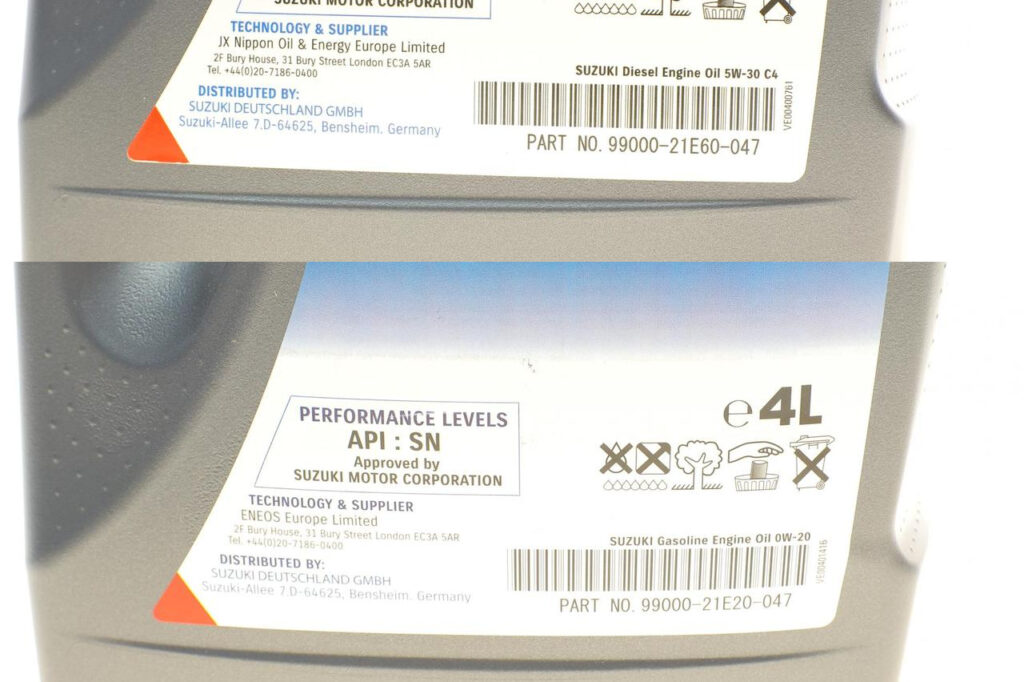
This is not the case for all Ecstar oils, though. The manual transmission fluid specified for the Jimny’s manual gearbox and all transfer cases appears to be manufactured by Shell in Japan.
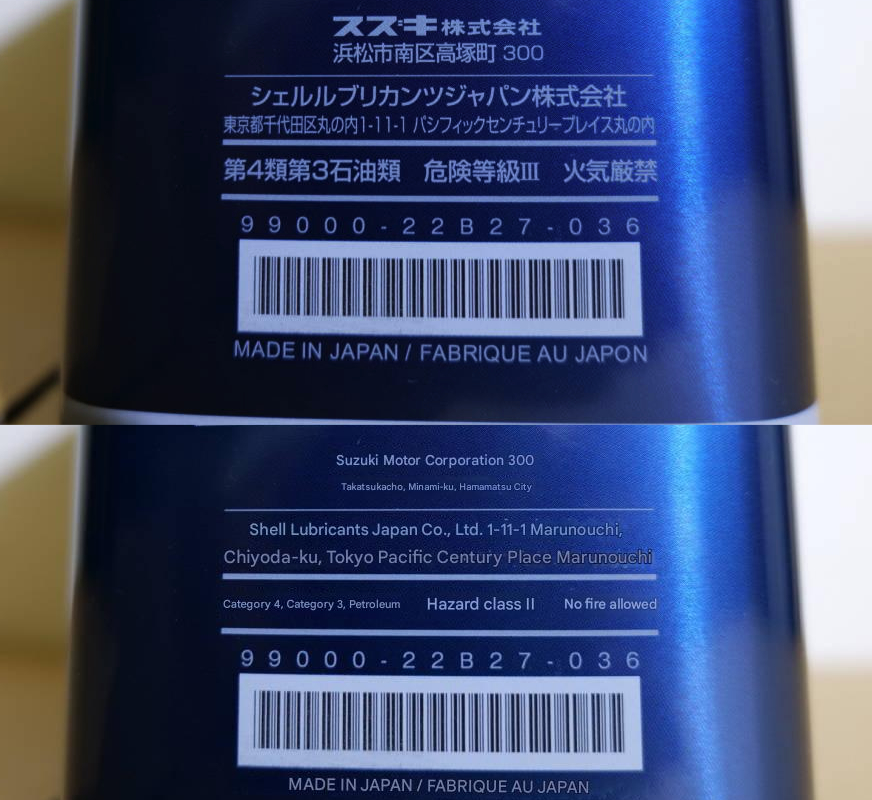
Maruti Suzuki also sources their lubricants but still packages them under the Ecstar branding, albeit with different branding to Japanese targeted Ecstar products. At least the engine oil relevant for the Jimny is produced by TotalEnergies India, a subsidiary of the French oil company Total much as Maruti is a sort of subsidiary of Suzuki.
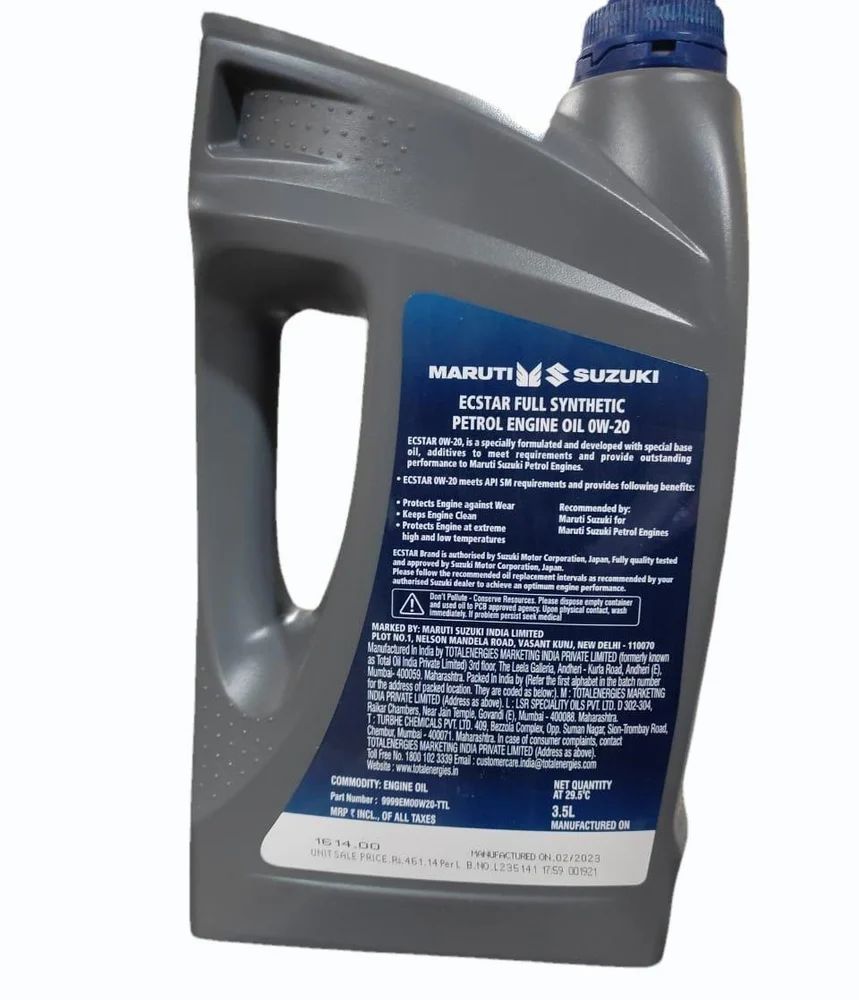
Suzuki marketing the same product using different suppliers, like the example of the Jimny’s engine oil produced by both ENEOS and TotalEnergies India, possibly indicate that Suzuki are not just doing a straight rebrand of an oil company’s product. This is also supported by the fact they are sourced from very different suppliers: Shell and Total are very much competitors, and it is usual that rebrand deals involve all product lines.
Some of these product lines get incredibly convoluted. A good example of this is the official ATF for the Jimny. The official fluid is Suzuki ATF3317. Product images for this aren’t always super easy to find with the manufacturer/distributor listed, but I did manage to find one.
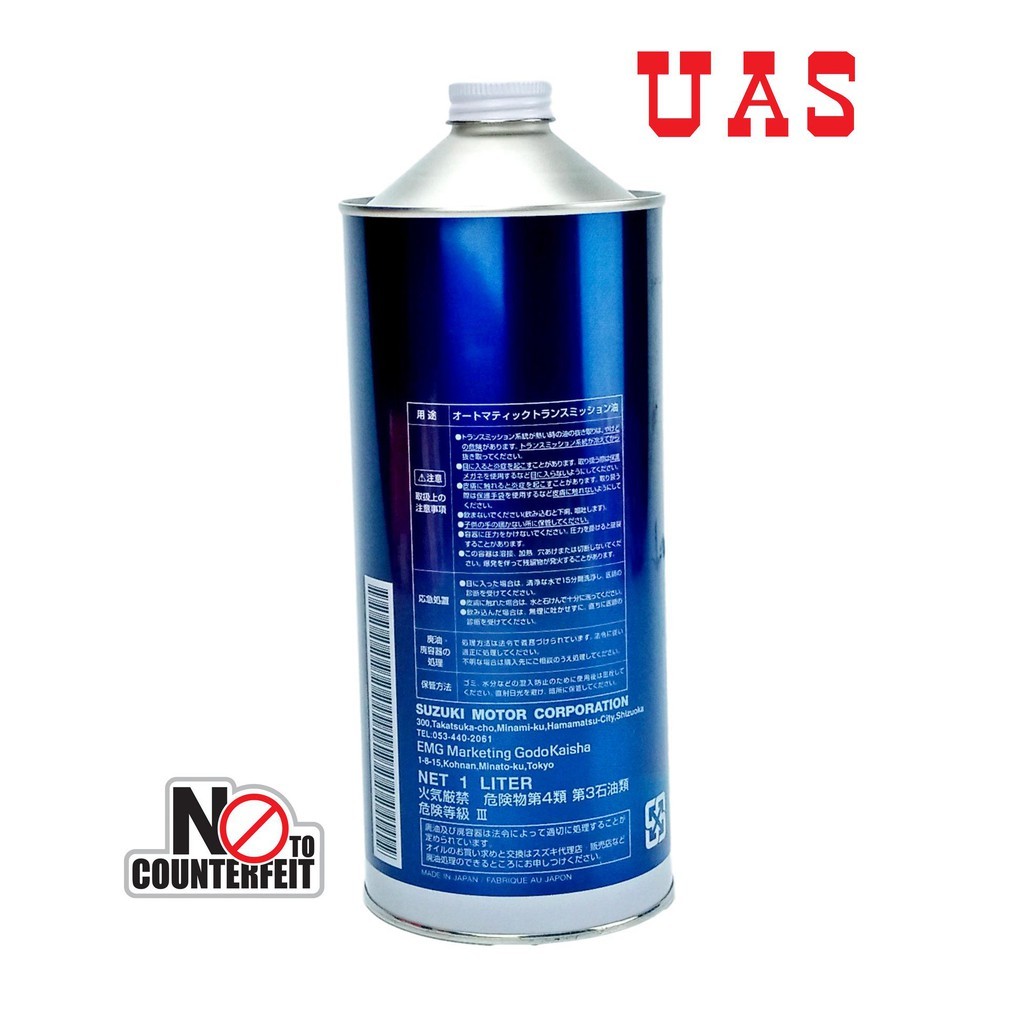
Understanding this takes a bit of untangling. EMG Marketing GodoKaisha refers to a distributor/marketer of oils; they are the main (only?) distributor for Mobil in Japan. This itself is already interesting, as the first ATF available at the Jimny’s launch that was explicit at meeting JWS3317/Suzuki 3317 was Mobil Multi Vehicle. This might be a hint as to the OE fluid used for the OEM Ecstar branded ATF, I guess.
More interestingly, EMG Lubricants (the effective parent of the company mentioned on the ATF) is owned, in turn, by JXTG, which was rebranded in 2018 to ENEOS, and mentioned on some of the earlier engine oil bottles. While this might eventually turn out to be a Mobil sourced product, it also could be regarded as an ENEOS product. The supply lines for these kinds of products can be moderately convoluted which is why it is never as simple as “an OEM doesn’t produce their own oil”. Potentially an oil company doesn’t, either.
Coolant is another tricky one to unravel. I was able to find an ebay auction listing with the following product image, indicating that the coolant comes from a corporation called CCI Corporation Ltd in the UK. They appear to have been dissolved in early 2020. There is a CCI Corporation that advertise producing coolants for many of the Japanese manufacturers, but they do not appear to manufacture a blue coolant for retail sale. This, again, might be indicative that the Suzuki coolant is designed to be different and more specific to Suzuki’s needs, and not just a rebranded OE fluid. There are other listings that also refer to CCI Corporation, e.g. highlighting that a Super Coolant Blue was manufactured in Germany for Ecstar.
Greases are another interesting one where there has been a lot of changes but it is incredibly opaque (and zero info on suppliers). Suzuki have often referred to only a few main greases:
- Super Grease A (99000–25011, superseded to 99000-25480, now superseded by Shell Gadus S2 V100 3): used for greasing a bunch of seals and pivots)
- Super Grease C (99000–25030, superseded to 99000-25490): used for CV joints, kingpin bearings and prop shafts)
- Waterproof grease (99000-25161, superseded to 99000-25350 – Ecstar Grease EP2)
- Brake grease with molybdenum disulfide (99000-79569): listed as the grease for sliding parts in rear drum; appears to be sourced from Kobe Gosei based on this product listing.
Note that Super Grease A has had the most changes. Part number 99000-25011 refers to it with the old Suzuki Genuine Parts branding, 99000-25480 is the part number for the Ecstar branded grease, and the Ecstar brochure now explicitly states it is superseded by Shell Gadus S2 V100 3. I guess that at least helps work out who supplies this grease now!

Super Grease C, used for stuff like kingpins and CV joints, is less definitive about supplier but also what grease it is. The original part number appears to be 99000–25030, and the Ecstar branded grease is 99000-25490. What’s interesting is that it is then described as “lithium grease, EP2”, which makes it sound like the Ecstar EP2, part number 99000-25350.
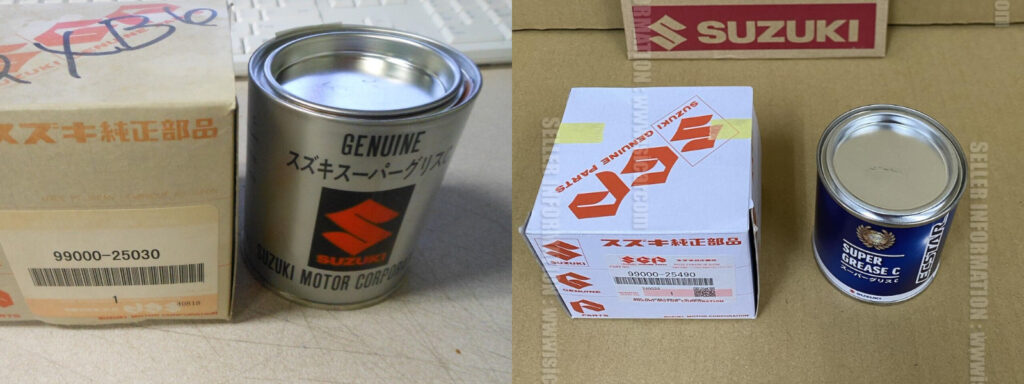
The catalogue for Ecstar only list the Shell replacement for Super Grease A and a waterproof EP2 grease, which might lend itself to suggesting that the replacement for Super Grease C is this EP2 grease. Hard to pin down any further but I’ll keep doing research into it.
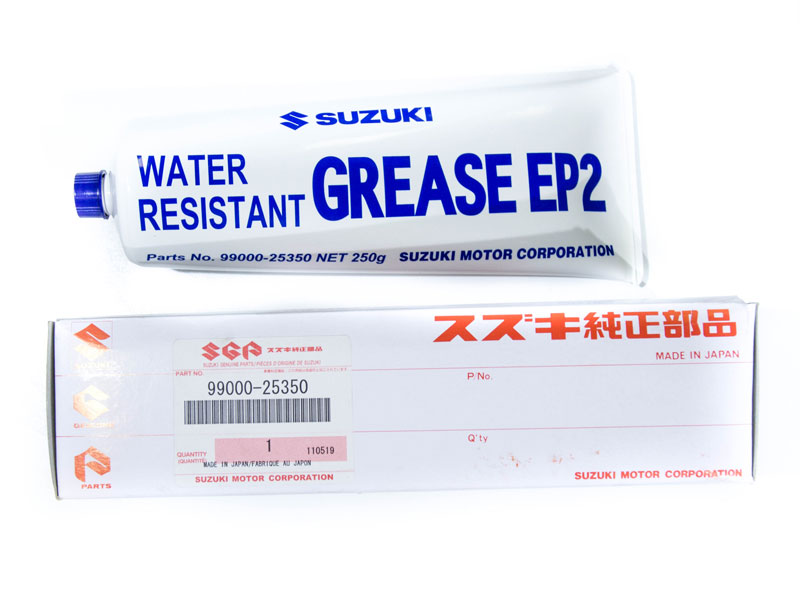
A final one that’s quite tricky to pin down is the OEM brake fluid. The Jimny only requires DOT 3, and there’s very limited back of bottle photos for the Ecstar DOT 3 fluid. A product listing for the Maruti DOT 3 does not indicate place or manufacturer contact details, and a Pakistan Suzuki product listing for the genuine DOT 3 fluid indicates only “made in Japan”. One for a Suzuki Indonesia sourced DOT 3 fluid is hard to read but appears to be manufactured by PTT Lubricants in Indonesia; perhaps it is more regionally sourced than some of the other products. This does make sense, due to the hydrophilic nature of brake fluid. In any case
Summing up, here’s what I’ve been able to compile relevant to the Jimny from looking at the back of way too many bottles in product listings in terms of info that might help understand sourcing.
| Application | Product | OE source | Reference image |
|---|---|---|---|
| Engine oil | F9000 0W-20 | ENEOS Europe / TotalEnergies India | Product listing |
| Manual transmission oil Transfer case oil | Gear Oil 75W | Shell Japan | Product listing -> Google translate |
| ATF fluid | Suzuki ATF3317 | EMG Lube (which is likely a subsidiary/has a relationship to ENEOS) / related to Mobil (possibly OE with Mobil ATF Multi-Vehicle) | Product listing -> Google translate -> EMG Lubricants -> Mobil distributor for Japan -> EMG Lube related to Eneos |
| Coolant | Super Long Life (blue) | CCI Corporation | Auction listing here |
| Brake fluid | Ecstar DOT 3 | Might be locally sourced? | Hard to find good product listings |
| Super Grease A | Lithium grease | Now is replaced by Shell Gadus S2 V100 3 | Ecstar product brochure |
Related: sealant and threadlockers
There’s a few sealants and threadlockers that Suzuki recommend. For the sealants the ones I have see in official procedures are as follows:
- Sealant, waterproof (99000-31250): Threebond 1207F
Used on waterpump to engine block face - Sealant, flexible silicone (99000–31260): Threebond 1217G
Used on things like the oil pan, or the joints between timing cover and cylinder head when fitting valve cover gasket - Sealant, fixed (99000–31110): Threebond 1215
Used on kingpins and areas such as the rear axle brake backing plate to axle housing - Sealant, high temperature oil safe (99000-31230): Threebond 1216
Used on the parking pawl in the automatic transmission
You’re unlikely to come across sealant 1216, so realistically you need 1217G for joining cases, 1215 for steering/wheel bearing renewal and 1207F if you’re going to replace the waterpump.
To help make a comparison to other compatible sealants, here’s the specs of just these 4 from Threebond’s catalogue.
| Threebond 1215B (99000-31110) | Threebond 1217G (99000-31260) | Threebond 1207F (99000-31250) | Threebond 1216 (99000-31230) | |
|---|---|---|---|---|
| Typical use | Sealing axle housings | Sealing cases, some drain plugs | Waterpump | Parking pawl (A/T) |
| Main component | Silicone | Silicone | Silicone | Silicone |
| Curing method | Solvent vaporization Oxime | Solvent vaporization Oxime | Solvent vaporization Acetone | Solvent vaporization Oxime |
| Features | For general use Chemical resistance | High elasticity High-grade engine oi | Fast-curing Cooling liquid resistance | Multigrade |
| Appearance | Black | Grey | Aluminum colour | Grey |
| Viscosity (Pa.s) | 85.0 | – | – | – |
| Apparent viscosity – SOD (Pa.s) | 20 | 301 | 180 | 120 |
| Specific gravity (g/cc) | 1.45 | 1.37 | 1.45 | 140 |
| Tack free time (mins) | 11 | 5 | 5 | 5 |
| Hardness | A40 | A60 | A59 | A60 |
| Elongation rate (%) | 380 | 430 | 190 | 240 |
| Tensile strength (MPa) | 1.2 | 2.6 | 3.7 | 3.0 |
| Use in engine oil | Suitable | Suitable | Suitable | Suitable |
| Use in gear oil | Suitable | Unsuitable | Unsuitable | Suitable |
| Use in ATF | Unsuitable | Unsuitable | Unsuitable | Not very suitable |
| Use in MT oil | Suitable | Unsuitable | Unsuitable | Suitable |
| Coolant | Unsuitable | Unsuitable | Suitable | Not very suitable |
| Mass change in water (%) | -0.4 | – | – | – |
| Mass change in gasoline (%) | -4.7 | – | – | – |
| Mass change in oil (%) | +4.9 | – | – | – |
| Operating temperature range | -60 to 200ºC | -60 to 200ºC | -60 to 200ºC | -60 to 200ºC |
| Notes | FIPG: Engine oil pan and Gear case sealing 1215 Color difference | FIPG: Engine oil pan sealing Excellent initial pressure resistance | FIPG: Engine oil and Cooling liquid sealing | FIPG: Engine oil pan, AT case, Gear case and Cooling liquid sealing |
What’s slightly interesting is they specify 1217G for use on drain plugs e.g. manual gearbox drain and fill plugs, but Threebond do not recommend 1217G for this application. It does work here for sealing threads, just an interesting difference. Threebond use the language “not very suitable” for ATF compatibility for 1216, but they do seem to recommend its use around ATF.
You don’t have to use the Threebond sealants as there are plenty of good similar sealants on the market. One of the key benefits to the Threebond sealants is they have better elongation rates than most RTV sealants available, but most of their applications do not require that level of elongation. The Permatex “optimum easy disassembly” RTVs are the ones with the closest levels of elongation and so might be the optimum choice, but the ultra grey/ultra black works well for replacing both 1215 and 1217G, though 1217 definitely disassembles easier and 1215 is harder to get apart. Note that Permatex Ultra Grey is less flexible than Ultra Black, so desipite the colour similarities the grey is a better match for 1215B than 1217G, and vice-versa for Ultra black.
Confusing? Yeah. Here’s some recommended alternatives based on properties and application.
1215B equivalents
Permatex optimum easy disassembly black
3M Ultrapro High Temp Silicone Gasket
JB Weld Ultimate Black
1217G equivalents
Permatex Ultra Black
3M Ultrapro High Temp Silicone Gasket
JB Weld Ultimate Grey
1207F equivalents
Permatex Water Pump & Thermostat sealant
JB Weld Blue RTV
1216 equivalents
Permatex Automatic Transmission sealant
Threadlockers are another example where you can use other brands.
Threadlockers are more often applied directly to bolt as applied, but one I have spotted being specified is 99000-32150. This is Threebond 1322D, described as medium strength threadlocker, and is only used to secure the gear shift stop bolt in manual transmissions. This would cross reference to Loctite 243, the blue medium strength oil safe thread locker.
Do I recommend the Suzuki OEM oils/fluids?
If you can get them at a price that’s similar to equivalent then I don’t see a reason not to run them. They are clearly produced by reputable suppliers and are made to Suzuki specifications. The same applies to OEM parts: in many cases it’s preferable to go the extra mile to get them purely from a specification perspective. Just because Suzuki are not an oil company doesn’t mean they can’t set specifications, especially based on their engineering requirements.
